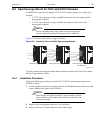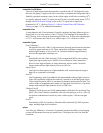
Appendix H Glossary 303
MCP
Micro-Channel Plate. Composed of cylindrical channels through which electrons from
the photocathode travel and generate additional electrons resulting in electron gain. At
the output of the MCP is a phosphor-coated fluorescent screen that converts the
electrons to photons that subsequently strike the CCD array and generate charge in the
array pixels.
MCP Bracket Pulsing
Available for PI-MAX4 cameras with Gen II intensifiers. This technique enhances the
intensifier's on/off ratio in UV measurements by automatically adjusting the on/off
switching of the MCP to bracket the photocathode gate pulse. By switching off the
MCP, unwanted UV signal that strikes the photocathode (even though gated off) is
prevented from passing through the MCP to integrate on the CCD array.
MCP Gating
Available for PI-MAX
MG
cameras. Applies the primary gating pulse to the MCP
portion of the tube and, if chosen by the user, applies the bracket pulse to the
photocathode.
MCP Resolution
The MCP is a slightly conductive glass substrate with millions of parallel traversing
channels containing a secondary electron emitter on their inner walls. The smaller the
diameter and more tightly grouped the channels, the higher the resolution.
Phosphor Decay Time
A delay between the end of the exposure time and the beginning of the array readout.
This time is inserted to allow the phosphor to decay to 1% before readout occurs and
will vary depending on the phosphor type.
Phosphor Type
A phosphor is a chemical substance that fluoresces when excited by x-rays, an electron
beam, or ultraviolet radiation. Phosphors usually emit green light with decay times
ranging from hundreds of nanoseconds to a few milliseconds. P43 offers high resolution
(~ 3 ms decay) while P46 offers fast decay for high-repetition rate spectroscopy (~ 2 µs
decay.) The P47 offers even faster decay (0.4 µs.) The Phosphor Decay Time, inserted
between the end of the exposure time and the beginning of the array readout, allows for
the decay time.
Photocathode Coatings
Coatings on the photocathode convert a portion of the incident photons into electrons.
Any photons that are not captured by the photocathode are lost from the final signal
produced by the intensifier. Therefore, the kind of coating and the resulting QE of the
photocathode is very important. The choice of coating determines the most effective
spectral range for the intensifier. For example GaAs (gallium arsenide) has high QE in
the VIS and NIR regions. Multi-alkali coatings have fair photoconversion in the visible
(VIS) and ultraviolet (UV) but have relatively limited response in the near IR (NIR.)
Pulse Ensemble
Consists of a Gate Start pulse, a Gate Stop pulse, and an Auxiliary pulse. At the end of
the ensemble, the photocathode is gated off, phosphor decay time elapses to allow for
phosphor decay, and then the CCD array is readout.


















